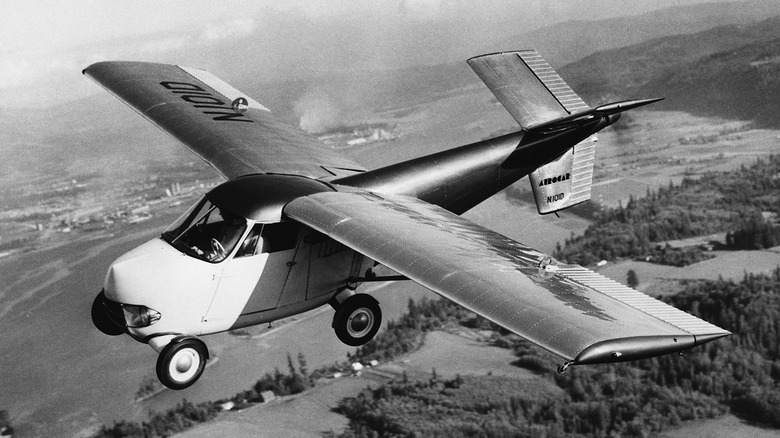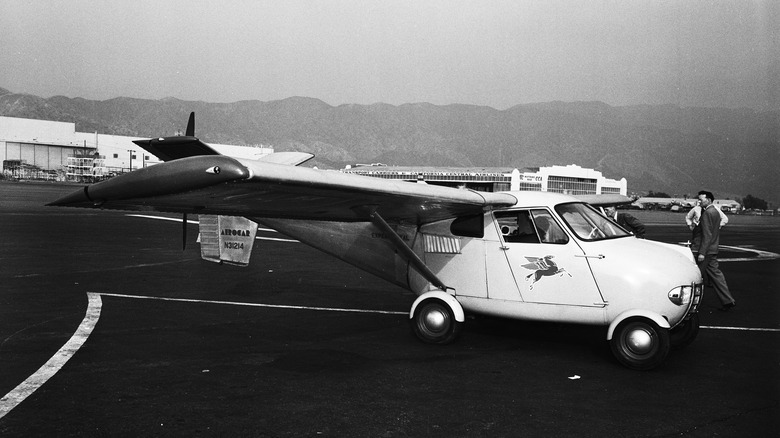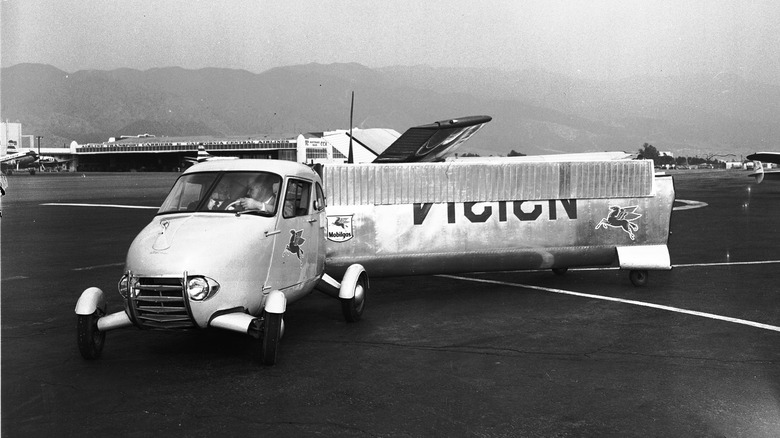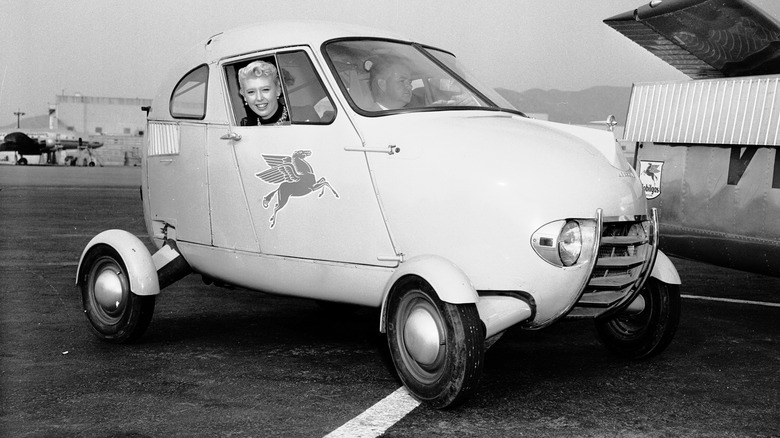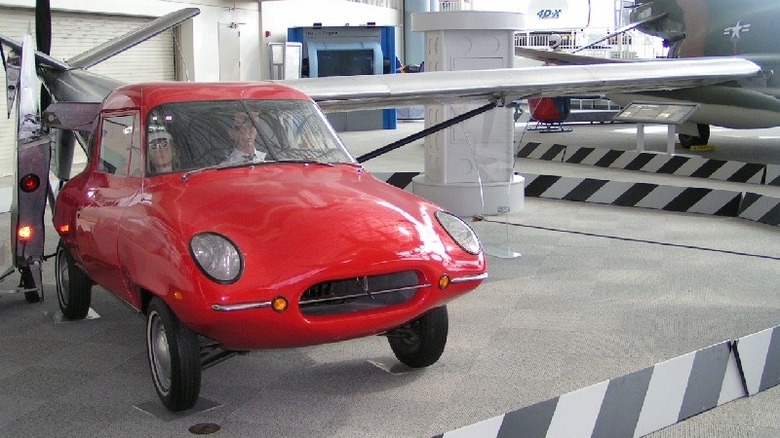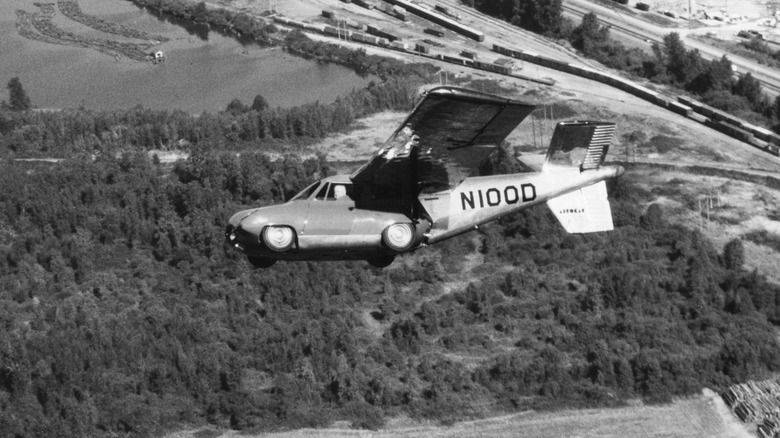What Happened To Aerocar International?
For many, the dream of a flying car remains the stuff of sci-fi fantasy. But in the 1940s, the dream of a roadable aircraft became a reality for Oregon native Moulton "Molt" Taylor, who devised a way to mount wings and a tailpiece to an automobile and took to the air in his very own car-plane hybrid, the aptly named "Aerocar."
As was often noted throughout Molt Taylor's life, the Aerocar was conceived in part as a way to give users the freedom to fly from one place to the next without relying on the schedules and regulations imposed by other means of air travel. He also wanted to manufacture a vehicle that the general public could actually buy and operate, thus making it possible for anyone to fly and drive wherever and whenever they wanted. Unfortunately, the Aerocar never took flight in mainstream transportation circles, dashing Taylor's dream of mass-producing the vehicle for the general public. Here's what happened to Aerocar International.
Taylor's Aerocar design was inspired by another flyable automobile
Molt Taylor's journey to bringing his Aerocar car to life begins with the young man earning an engineering degree from the University of Washington. A lifelong fan of aviation, Taylor during World War II, Taylor joined the U.S. Navy as a pilot during World War II, during which he was awarded the prestigious Legion of Merit for his contributions to the first successful firing of a surface-to-surface missile. He'd go on to lead the team that developed the first cruise missiles.
After the war, Taylor declined offers to continue working for the military and instead went back to Oregon to develop his plans for the flyable and drivable Aerocar. You may not know it, but the ambitious inventor took inspiration for the Aerocar from inventor Robert Fulton Jr.'s failed Airphibian design. Fulton's Airphibian was the first roadable aircraft awarded certification by the Civil Aviation Administration.
Certification aside, Fulton's Airphibian failed to gain traction in the transportation market. Though Fulton abandoned the roadable concept, Taylor continued to develop a road-ready aircraft and even fixed some of the issues that may have doomed the Airphibian to failure.
Taylor made a design breakthrough before Aerocar took flight
Molt Taylor encountered the Airphibian in 1946 and quickly set about tweaking the fixed wings and tail design when working up the Aerocar concept. The issue in Taylor's eyes was that the fixed-wing design required the backend of the Airphibian to be stored in a hangar at an airport when detached, which didn't jibe with Taylor's desire to operate a roadable as free from airport reliance as possible. By 1949, Taylor had solved the problem, designing an ingenious tailpiece with wings that could be folded down when detached and transported by the car with a trailer hitch.
Aerocar's folding design meant the wings and tailpiece could be stored at home and driven to an airstrip whenever the owner wanted to fly. Perhaps equally important was Taylor's decision to move the propeller to the rear end of the craft, meaning it did not need to be removed before you could drive the car. Perhaps most importantly, the transportable wings meant you could simply drive to a different airport for your next trip.
The fresh design elements also meant the Aerocar could be flight-ready in mere minutes, with Taylor and company completing a prototype in 1949. A year later, Taylor's dream of a flyable car became a reality when Aerocar made its first flight.
Taylor was plotting big things for the Aerocar empire
With a functional Aerocar prototype ready to fly, Molt Taylor and his team believed they'd hit upon a revolutionary new mode of transportation that could put the power and convenience of flight in the hands of anyone who could afford it. The Aerocar would come with a $25,000 price tag, however, likely limiting its consumer potential even in a market brimming with newly-trained pilots who learned how to fly for the war effort.
Nonetheless, after demonstrating Aerocar's capabilities, Aerocar International was flooded with inquiries. With Taylor beating the drum of the vehicle at auto shows across the country and promoting it on television and in newsreels, interest in the roadable plane only grew. At one point in time, Taylor had even secured nearly 300 $1,000 down payments with eyes on selling Aerocars to the masses. A prototype of the Aerocar was even being utilized as a traffic spotter by a local radio station in Taylor's hometown of Portland, Oregon.
With a seemingly bright future ahead, Taylor set about perfecting the Aeroplane's designs. In doing so, he sought to maximize its appeal in the transportation market.
Taylor's Aerocar underwent a few redesigns before Aerocar International folded
By 1956, marketing Molt Taylor's Aerocar to the general public looked closer than ever to becoming a reality. When it was certified as air-ready by the Civil Aviation Authority, it became the first vehicle in history to get the green light from a federal agency for use both on the road and in the air. With avenues opening for Aerocar, the sky legitimately seemed the limit for Molt Taylor's car-plane hybrid.
Despite the positive buzz surrounding Aerocar, Taylor struggled to find a mass-market production deal for his roadable, which led to some tinkering with the vehicle's design in the 1960s and 1970s. The first round of redesigns was radical, to say the least, with Aerocar II proving the lone model of the vehicle was non-roadable despite its name boasting otherwise.
Taylor and the team returned to basics with Aerocar III, producing a fully roadable vehicle that was also fit for the air. The two-seat car-plane arrived with a sleeker body and a more powerful engine, but the biggest design upgrade for Aerocar III was arguably its partially retractable wheels, which not only increased the vehicle's airspeed but also helped make for a smoother flight.
Some shady business dealings doomed the Aerocar dream
The sleekly redesigned Aerocar III found favor with executives at Ford Motor Company in the early 1970s, with then-company president Lee Iacocca reportedly going so far as to order a feasibility study to determine the commercial appeal of the roadable. Though the numbers were promising, there was serious concern about whether the federal government would allow potentially thousands of vehicles to traverse the airwaves daily. On top of that, the U.S. was then mired in the nation's worst oil crisis.
Despite the pass from Ford, at one point in Aerocar International's history, Taylor had brokered a deal to build his roadable planes at a factory in Texas. Unfortunately, the deal fell through, with Taylor discovering the bulk of his company's investment money had been callously squandered before production could begin.
Aerocar International never fully recovered, though Taylor continued to refine Aerocar's design and champion his flying car concept until his 1995 death. In the end, only a few Aerocar prototypes were ever built and are now mostly display pieces in various aviation museums. Though Molt Taylor's dream of a mass-market airborne roadable remains unrealized, companies continue to develop flying cars, and that means we may one day be piloting those great unused highways in the sky in a carplane of our own.
